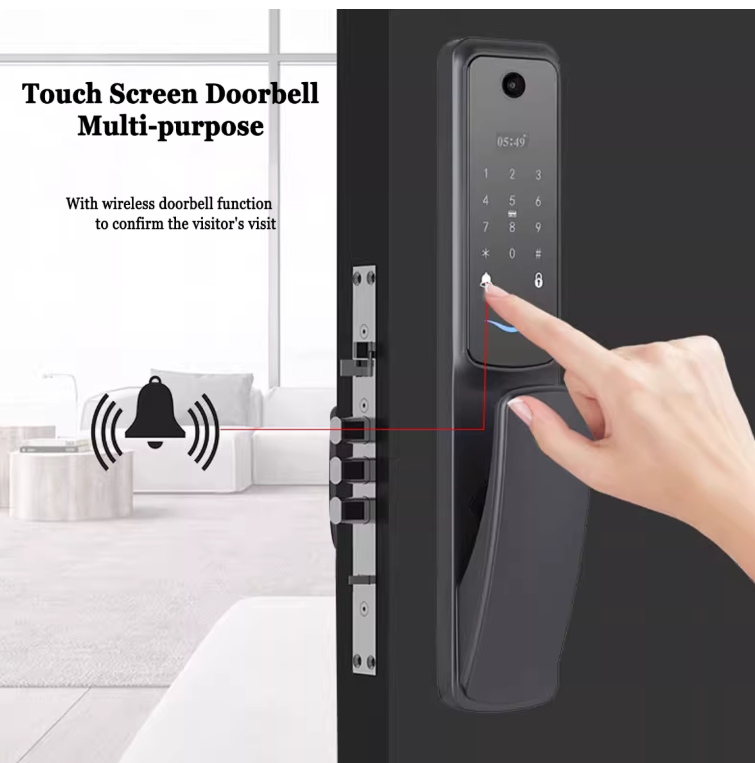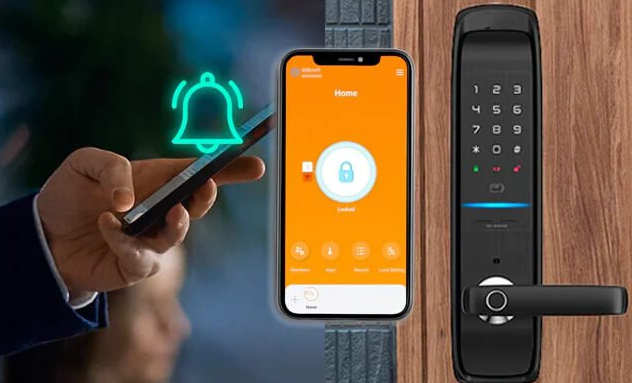home security is no exception. Smart locks, the modern evolution of traditional door locks, have revolutionized how we secure our homes, offering convenience, enhanced security, and seamless integration with smart home systems. Unlike mechanical locks that rely solely on physical keys, smart locks use digital technology to provide keyless entry, remote access, and advanced security features. Since their introduction in the early 2010s, smart locks have become a cornerstone of the smart home revolution, blending cutting-edge technology with user-friendly design.
This comprehensive guide explores the world of smart locks, delving into their technology, benefits, security considerations, and future trends. Whether you’re a homeowner looking to upgrade your security or a tech enthusiast curious about the latest innovations, this article will provide valuable insights into the world of smart locks and help you make informed decisions.

What Are Smart Locks?
Smart locks are advanced locking devices that use electronic and digital technology to secure doors without the need for traditional keys. Unlike conventional locks, smart locks offer multiple access methods, such as PIN codes, biometric authentication (fingerprint or facial recognition), smartphone apps, or voice commands. They are designed to integrate with smart home ecosystems, allowing users to control and monitor their locks remotely.
Types of Smart Locks
-
Keypad Locks: Use a numeric or touchscreen keypad to enter a PIN code.
-
Biometric Locks: Utilize fingerprint or facial recognition for secure access.
-
Bluetooth Locks: Connect to smartphones via Bluetooth for proximity-based unlocking.
-
Wi-Fi Locks: Enable remote access and control through internet connectivity.
Key Components
-
Hardware: Includes the lock mechanism, keypad or sensor, and connectivity modules (Bluetooth, Wi-Fi, Z-Wave, Zigbee).
-
Software: Mobile apps or cloud-based platforms for remote management and monitoring.
-
Connectivity: Links the lock to smartphones, smart hubs, or voice assistants like Amazon Alexa, Google Home, or Apple HomeKit.
Integration with Smart Homes
Smart locks seamlessly integrate with smart home systems, allowing users to control lights, thermostats, and locks from a single app or voice command. This connectivity enhances home automation, making daily routines more convenient and efficient.
How Smart Locks Work
Smart locks operate using a combination of electronic components, software, and connectivity protocols. Here’s a breakdown of their functionality:
Operational Mechanisms
-
Bluetooth: Connects the lock to a smartphone within a short range (typically 30-100 feet).
-
Wi-Fi: Enables remote access from anywhere with an internet connection.
-
NFC/RFID: Allows keyless entry using near-field communication or radio-frequency identification tags.
-
Z-Wave/Zigbee: Connects to smart home hubs for broader integration.
Authentication Methods
-
PIN Codes: Users enter a unique code on a keypad or touchscreen.
-
Biometrics: Fingerprint or facial recognition ensures only authorized users gain access.
-
Mobile Apps: Smartphone apps allow users to lock, unlock, or share access remotely.
-
Voice Control: Integration with voice assistants enables hands-free operation.
Power Sources

Most smart locks are battery-powered, typically using AA or AAA batteries, lasting 6-12 months depending on usage. Some models include backup options, such as a mechanical key or a power port for emergency charging.
Installation and Compatibility
Smart locks are designed to fit most standard doors, replacing existing deadbolts or mortise locks. Installation is straightforward, often requiring only a screwdriver and basic DIY skills. Compatibility varies by model, so checking door measurements and lock type is essential before purchase.
Benefits of Smart Locks
Smart locks offer numerous advantages over traditional locks, making them a popular choice for modern homes.
Convenience
-
Keyless Entry: Eliminates the need to carry physical keys, reducing the risk of loss or theft.
-
Remote Access: Lock or unlock your door from anywhere using a smartphone app.
-
Guest Codes: Share temporary or permanent access codes with family, friends, or service providers.
-
Activity Logs: Monitor who enters and exits your home with real-time notifications.
Enhanced Security
-
Encryption: Uses advanced encryption protocols (e.g., AES-128 or AES-256) to protect data.
-
Tamper Detection: Alerts users to unauthorized attempts to access the lock.
-
Auto-Lock: Automatically locks the door after a set period, ensuring security.
-
Geofencing: Locks or unlocks based on your smartphone’s location, adding convenience and safety.
Smart Home Integration
Smart locks work with platforms like Amazon Alexa, Google Home, and Apple HomeKit, allowing seamless control alongside other smart devices. For example, you can program your lock to unlock when you arrive home and turn on the lights simultaneously.
Cost-Effectiveness and Energy Efficiency
While smart locks may have a higher upfront cost than traditional locks, their durability, low maintenance, and energy-efficient design make them cost-effective over time. Battery-powered models require minimal power, and some locks feature low-battery alerts to prevent lockouts.
Security Considerations
While smart locks offer advanced security features, they also come with unique challenges that users must address to ensure safety.
Cybersecurity Risks
-
Hacking: Weak encryption or outdated firmware can make smart locks vulnerable to cyberattacks.
-
Data Privacy: Cloud-based apps may store sensitive access data, requiring robust security measures.
-
Solutions: Use strong, unique PINs, enable two-factor authentication, and regularly update firmware to mitigate risks.
Physical Security
-
Anti-Theft Features: High-quality smart locks use reinforced materials to resist lock picking and forced entry.
-
Durability: Weather-resistant designs ensure functionality in extreme conditions (e.g., rain, heat, cold).
-
Tamper Alerts: Immediate notifications for suspicious activity enhance physical security.
Best Practices
-
Choose complex PIN codes and change them regularly.
-
Enable two-factor authentication for app-based access.
-
Keep firmware updated to protect against vulnerabilities.
-
Use trusted brands with strong security certifications (e.g., ANSI/BHMA Grade 2 or 3).
Choosing the Right Smart Lock
Selecting the perfect smart lock depends on your specific needs, budget, and home setup.
Factors to Consider
-
Door Compatibility: Ensure the lock fits your door type (deadbolt, mortise) and thickness.
-
Connectivity Needs: Choose between Bluetooth, Wi-Fi, or Z-Wave based on your smart home setup.
-
Budget: Prices range from $50 to $300, depending on features and brand.
-
Aesthetics: Select a design that matches your home’s style (e.g., modern, traditional).
Popular Brands and Models
-
August: Known for Wi-Fi connectivity and sleek designs.
-
Yale: Offers reliable biometric and keypad options.
-
Schlage: Combines durability with smart home integration.
-
Kwikset: Affordable and versatile, with multiple access methods.
Installation and Maintenance Tips
-
Follow the manufacturer’s installation guide for proper setup.
-
Regularly check battery levels and replace them as needed.
-
Clean the lock’s exterior to maintain its appearance and functionality.
-
Test connectivity periodically to ensure seamless app performance.
User Reviews and Ratings
Research user reviews on platforms like Amazon or Best Buy to gauge real-world performance. Look for feedback on ease of installation, reliability, and customer support. Trusted brands typically have higher ratings and better warranties.
Future Trends in Smart Lock Technology
The smart lock industry is rapidly evolving, driven by advancements in technology and growing demand for home automation.
Advances in Biometrics
-
Next-generation biometric locks will feature faster, more accurate fingerprint and facial recognition.
-
Multimodal biometrics (e.g., fingerprint + voice) will enhance security.
AI and Machine Learning
-
AI-powered locks will learn user habits, optimizing access schedules and security settings.
-
Predictive maintenance alerts will improve lock longevity.
Enhanced Connectivity
-
5G integration will enable faster, more reliable remote access.
-
Matter, a new smart home standard, will improve interoperability among devices.
Sustainability
-
Energy-efficient designs will reduce battery waste.
-
Solar-powered smart locks may emerge for eco-conscious consumers.
Compact and Stylish Designs
-
Future locks will prioritize sleek, minimalist aesthetics.
-
Customizable finishes will cater to diverse home décors.
Conclusion
Smart locks represent a significant leap forward in home security, combining convenience, advanced technology, and robust protection. With features like keyless entry, remote access, and smart home integration, they offer unparalleled flexibility for homeowners. However, users must remain vigilant about cybersecurity and maintenance to maximize security.
As smart lock technology continues to evolve, we can expect even more innovative features, from AI-driven functionality to sustainable designs. Whether you’re upgrading your home or exploring smart home solutions, a smart lock is a worthy investment in safety and convenience. Visit trusted retailers or brand websites like August, Yale, or Schlage to find the perfect smart lock for your needs.